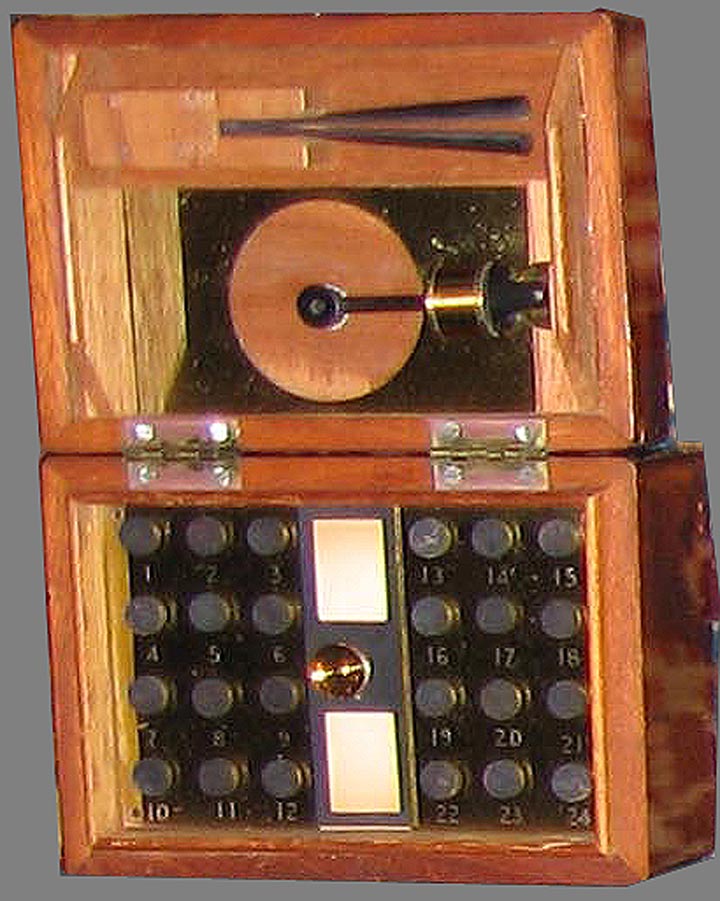COMPOUND UNIVERSAL MICROSCOPE
MAKER: R & J Beck
MODEL: 'INTERNATIONAL No 1' or 'LARGE BEST' or 'GRAND' MICROSCOPE or 'IMPROVED MICROSCOPE WITH SWINGING SUBSTAGE'
c. 4th QTR 19TH C.
SIGNED: 'R. & J. BECK, LONDON & PHILADELPHIA'
Please Click On Any Picture for a Larger Version
DESCRIPTION: This is a Wenham-type Binocular Lister-limb microscope which arises from a flat tripod. On top of the tripod is a revolving silvered calibrated plate on top of which two pillars are erected to accept the rest of the microscope on top via trunnion joint. An ivory handle (D in the engraving), controls the tension on the trunnion joint, allowing the microscope to be firmly secured at any desired angle of inclination.
The substage housing is supported on a tailpiece separate from that for the mirror. Focusing of the substage housing is by rack and pinion. There is no provision for centering the substage and no provision for rotation of the accessory it holds except with an additional accessory fitting(see accessories, below). The mirror can be removed from its fixed tailpiece (V in the engraving), and instead be attached to U, the tailpiece for the substage.
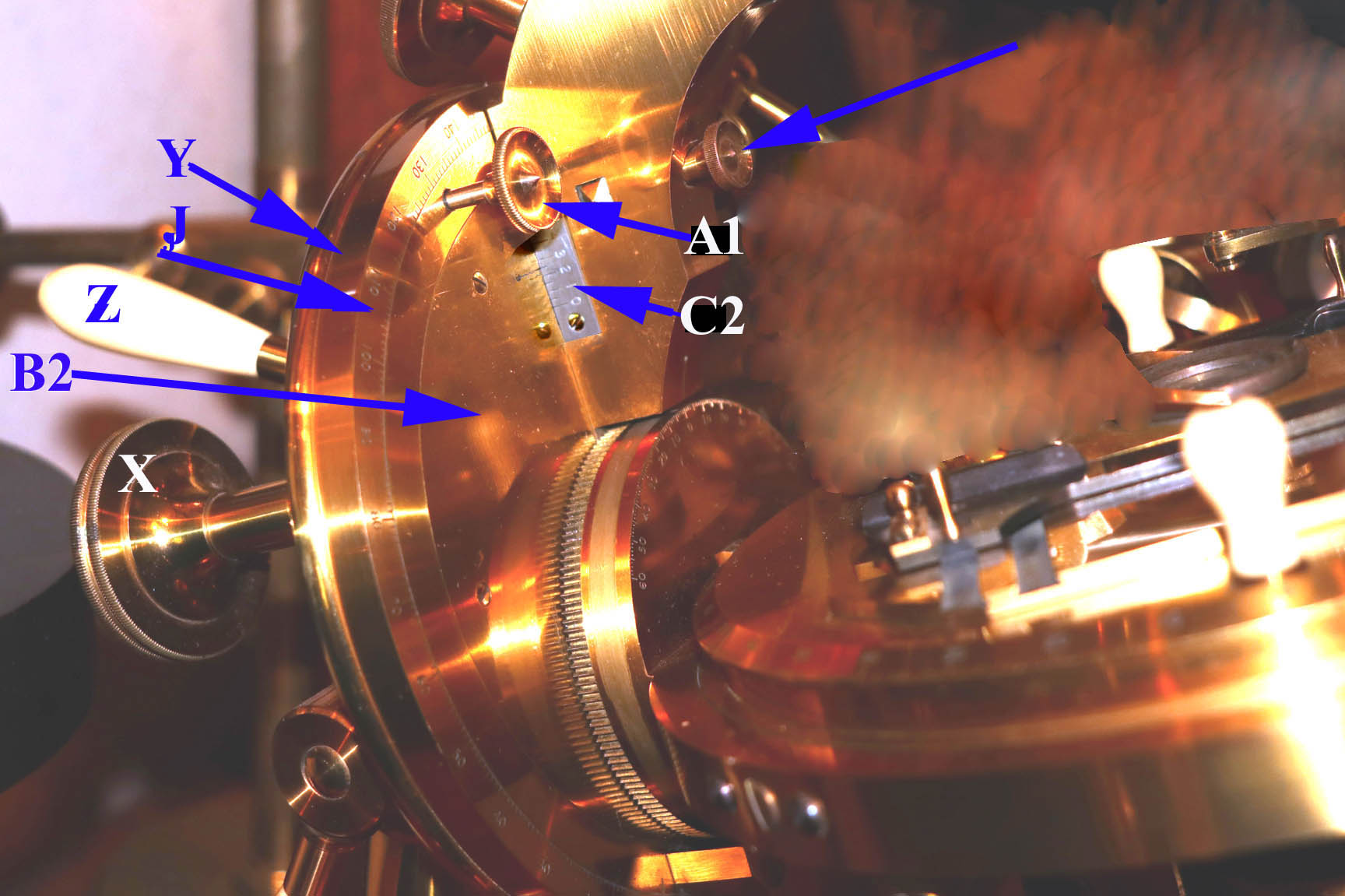 The substage tailpiece is attached to a large disc (B2)which rotates inside ring Y and registers its angle on the scale J. It can be manually swung to any angle below or above the stage, or with the knob X pushed in, rotated by rack and pinion. This entire unit, of the calibrated ring, disc, and the the attached tailpiece can be raised or lowered by the lever Z. This allows the center of rotation of the swinging tailpiece to be set at the level of the center of the specimen, regardless of where it is located relative to the surface of the stage. There is a scale on the limb(C2) which registers the vertical position of the disc supporting the swinging tailpiece. This avoids having to refocus the illuminating apparatus with different objectives if the specimen is not exactly at the level of the surface of the stage. When lever Z is used for this purpose, the stage and optical tube do not move. A pin attached to a knob(A1), when pushed in, registers on the disc to lock it in the vertical position.
The substage tailpiece is attached to a large disc (B2)which rotates inside ring Y and registers its angle on the scale J. It can be manually swung to any angle below or above the stage, or with the knob X pushed in, rotated by rack and pinion. This entire unit, of the calibrated ring, disc, and the the attached tailpiece can be raised or lowered by the lever Z. This allows the center of rotation of the swinging tailpiece to be set at the level of the center of the specimen, regardless of where it is located relative to the surface of the stage. There is a scale on the limb(C2) which registers the vertical position of the disc supporting the swinging tailpiece. This avoids having to refocus the illuminating apparatus with different objectives if the specimen is not exactly at the level of the surface of the stage. When lever Z is used for this purpose, the stage and optical tube do not move. A pin attached to a knob(A1), when pushed in, registers on the disc to lock it in the vertical position.
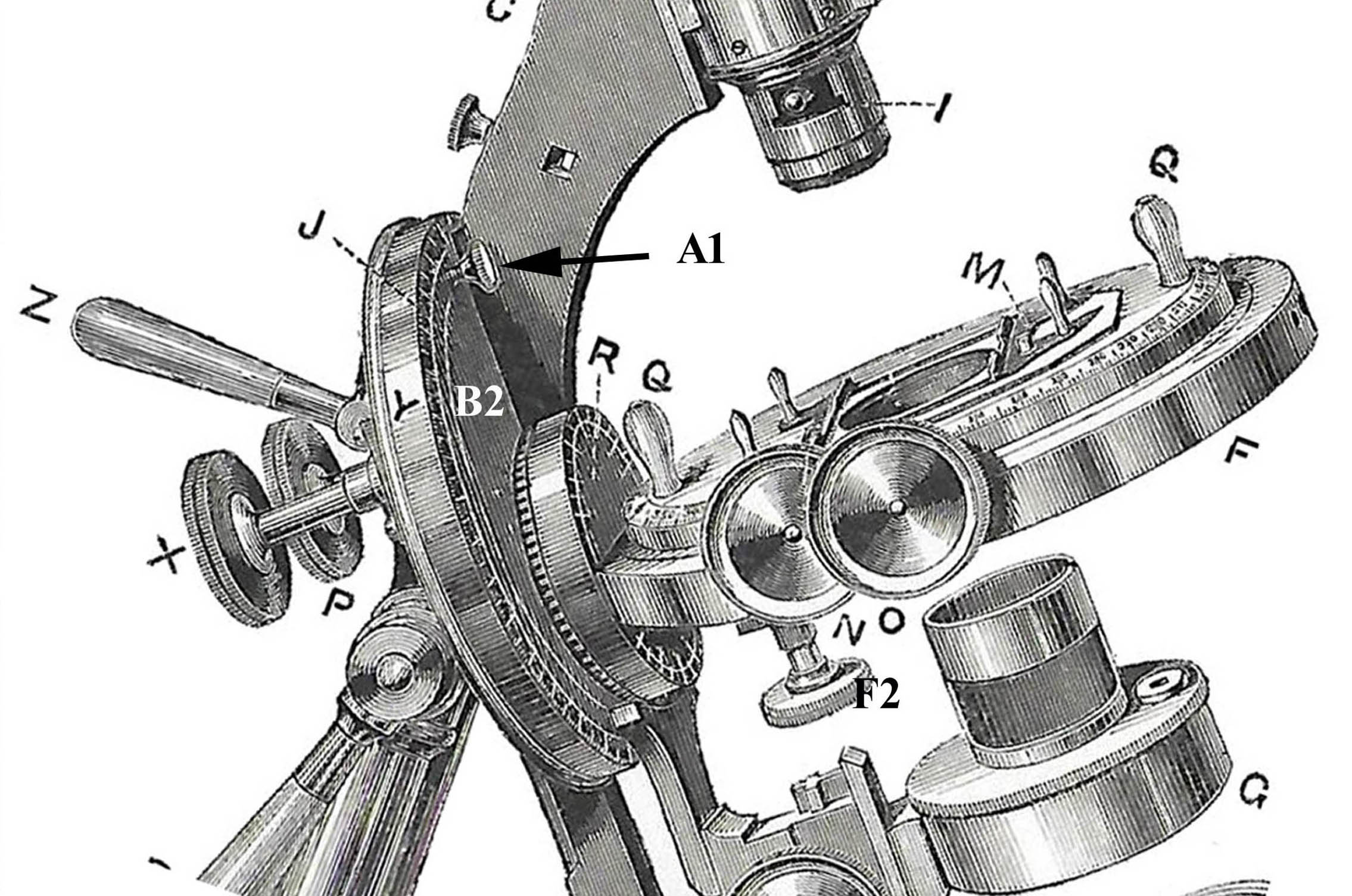 The stage itself has X and Y adjustments for the slide holder via knobs N and O. The stage can be rotated by hand on the horizontal axis by the knobs Q, or with the pinion of knob F2 engaged. The stage rotation is calibrated. The entire stage, attached to circular calibrated plate R, may be rotated manually or with rack and pinion via knob P, and the range of rotation is so complete as to allow the entire stage to be turned upside down to allow extreme oblique illumination at a very acute angle that would not be possible if the slide were on top of the stage in the usual way.
The stage itself has X and Y adjustments for the slide holder via knobs N and O. The stage can be rotated by hand on the horizontal axis by the knobs Q, or with the pinion of knob F2 engaged. The stage rotation is calibrated. The entire stage, attached to circular calibrated plate R, may be rotated manually or with rack and pinion via knob P, and the range of rotation is so complete as to allow the entire stage to be turned upside down to allow extreme oblique illumination at a very acute angle that would not be possible if the slide were on top of the stage in the usual way.
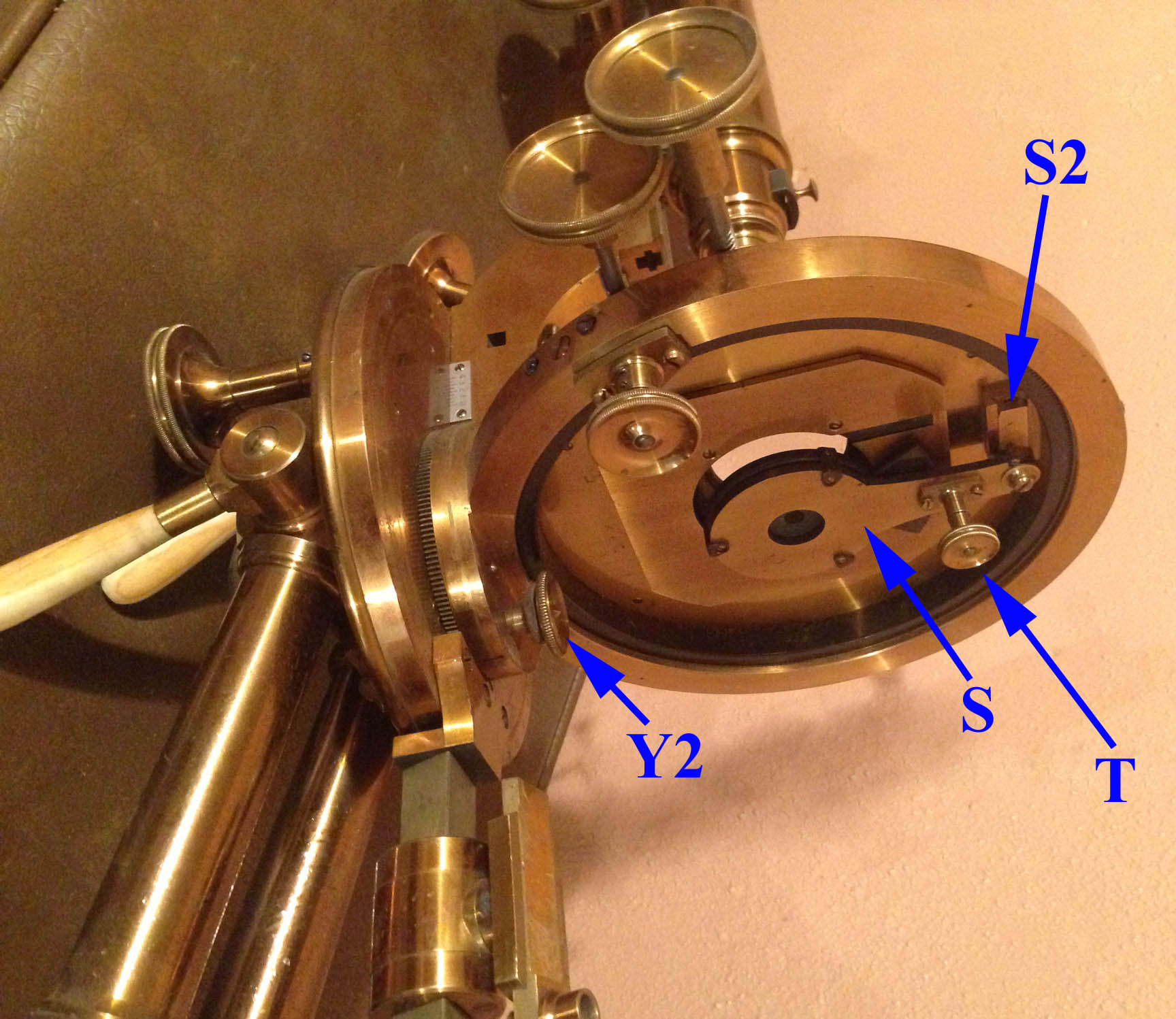 Beneath and attached to the stage is an iris diaphragm, S which can be removed from its dovetailed fitting, S2. The variations in the aperture of this diaphragm are made by a pinion working into a racked arc adjusted by the knob T. Y2 is a pin which when pushed in, fixes the rotation of the stage in the horizontal position.
Beneath and attached to the stage is an iris diaphragm, S which can be removed from its dovetailed fitting, S2. The variations in the aperture of this diaphragm are made by a pinion working into a racked arc adjusted by the knob T. Y2 is a pin which when pushed in, fixes the rotation of the stage in the horizontal position.
Depending on the year made, the arm of the limb has one or two square holes to accept accessories such as a side reflector, and each hole has a set screw to hold the accessory in place. The Binocular tube makes use of a Wenham prism which can be slid out for the use of a single tube as a monocular microscope. Coarse focus and interpupillary adjustments are by rack and pinion. Fine focusing was by short lever at the front of the nosepiece on the early examples but later examples have long lever fine focus through the Lister limb.
ACCESSORIES:
This microscope was available alone or with a variety of groups of accessories of various sizes, culminating in the boxes shown below which contain virtually every accessory Beck sold:
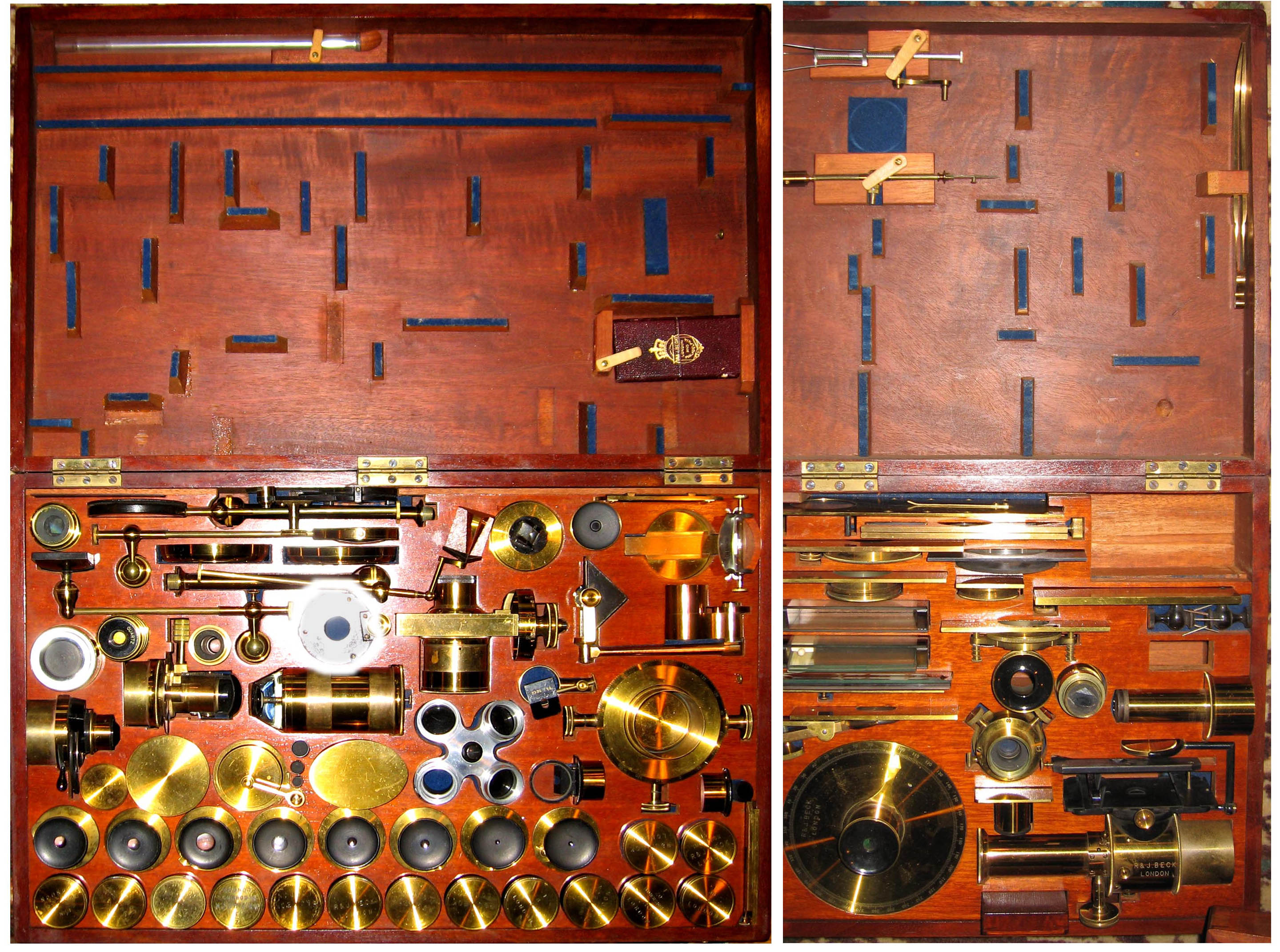 This is the most complete set of accessories that was available with the International model. It may be the most complete set ever offered in a catalog listing for any microscope. Some of the accessories seem a bit reduntant. For example there are three camera lucidas including the simplistic Beale type.
This is the most complete set of accessories that was available with the International model. It may be the most complete set ever offered in a catalog listing for any microscope. Some of the accessories seem a bit reduntant. For example there are three camera lucidas including the simplistic Beale type.
The following is a list of accessories which are further identified in the box and in some cases on dedicated pages available via the links. Note that some links are to pages about the same accessory, but associated with a different microscope.
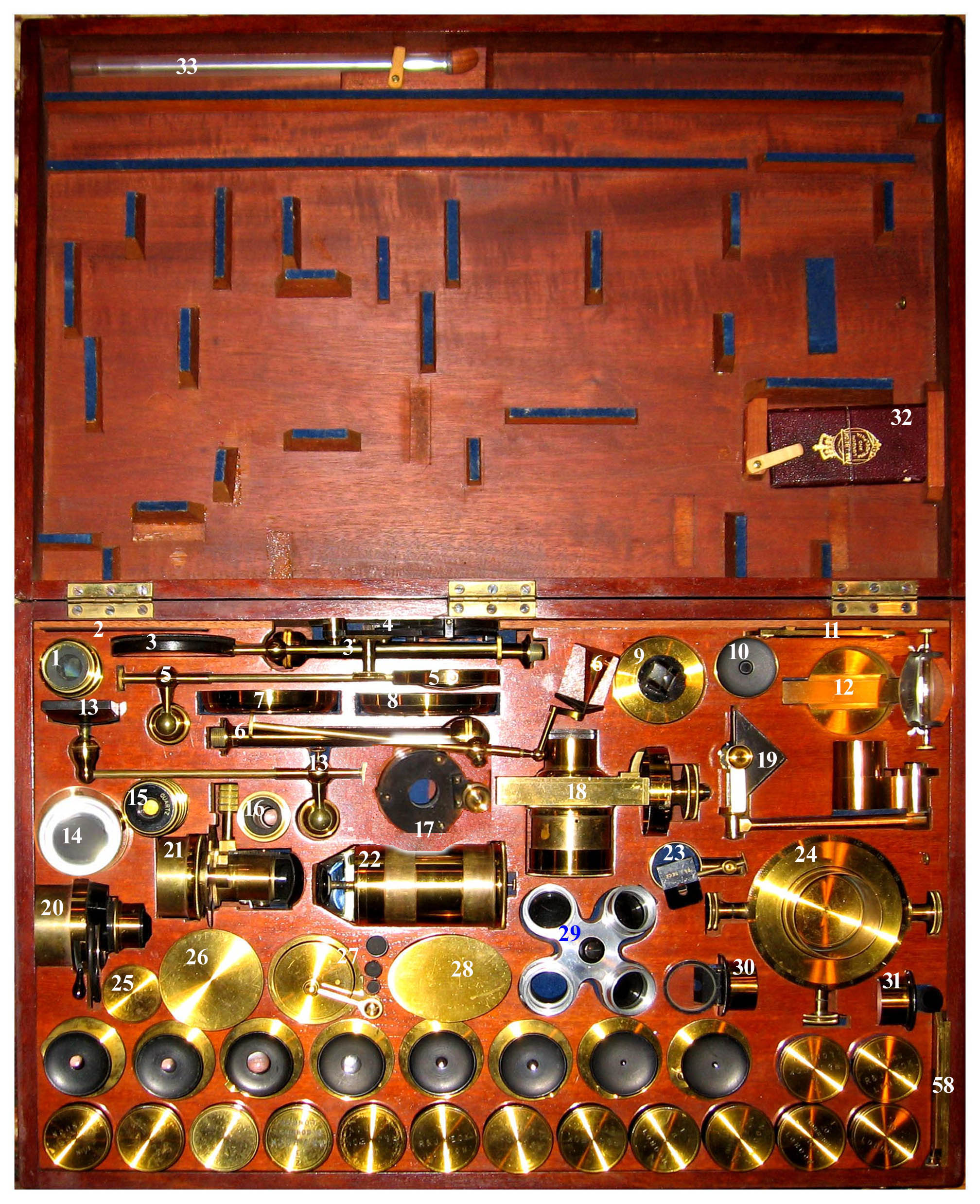
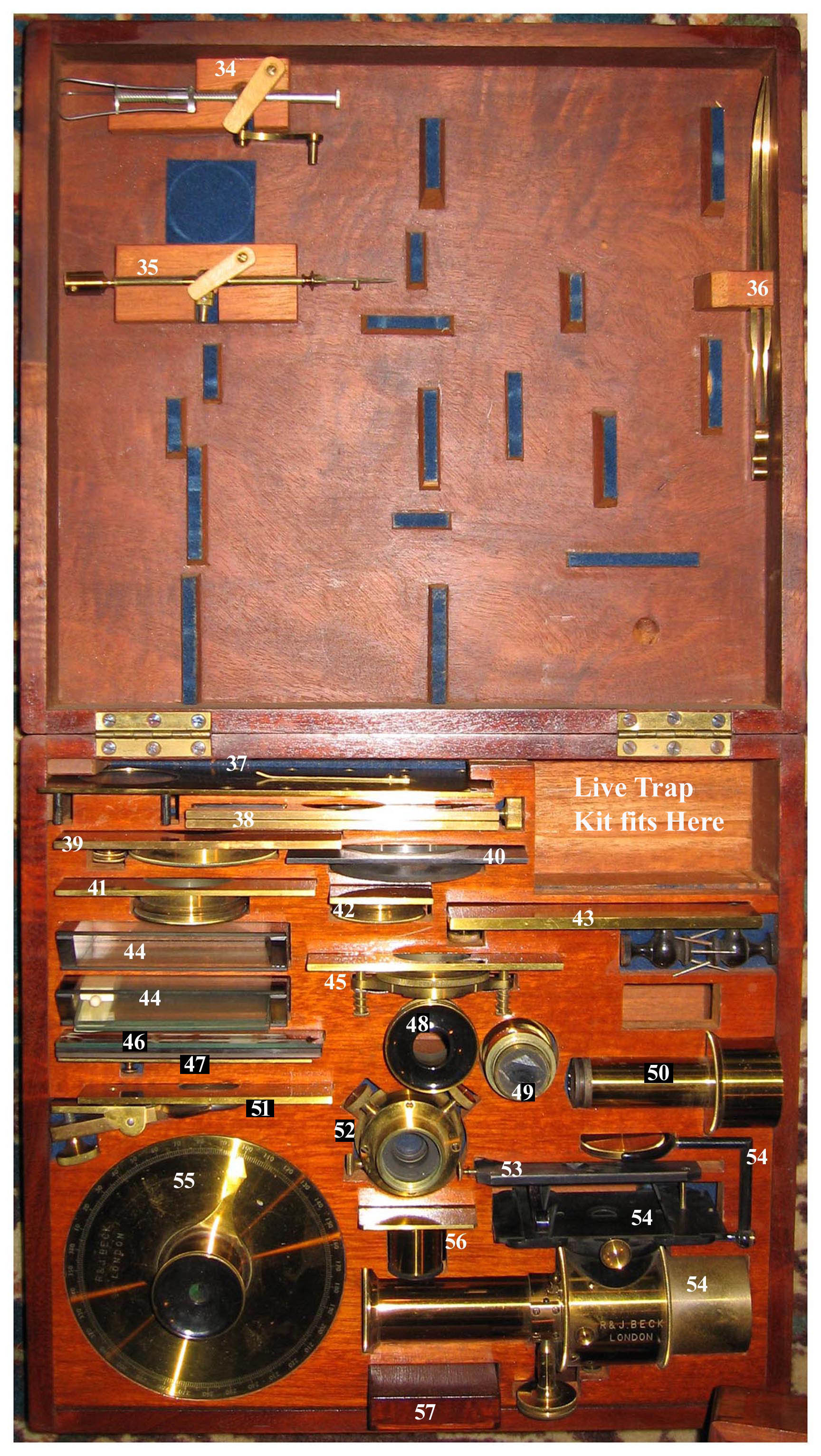
- Two Eyepiece Cap Analyzers stacked on top of an eyecap selenite
- Perforated Black Metal Slide for Double Prism Experiments
- Freestanding Blue Glass Moderator (a blue light filter)
- Substage Iris Diaphragm
- Limb-mounting Bullseye Condenser
- Equilateral Prism (freestanding)
- Base for Blue Glass Moderator
- Base for Equilateral Prism
- Nachet's Substage Prism
- Tourmaline Eyepiece Cap Analyzer
- Accessory Stage Clips which dovetail into part of the stage when top of stage is removed
- Substage Amici Prism
- Silver Side reflector
- 'Spot Lens' Low power dark ground condenser
- Set of 6 stacked eyepiece cap crystals (for studying their conoscopic images)
- Erecting lens (eliminates the apparent reversed movement in the eyepiece, allowing easier dissection and similar work)
- Iris Diaphragm to fit substage
- Eyepiece Micrometer
- Substage Right Angle Prism
- Achromatic Condenser with two wheels of apertures and an iris diaphragm
- Beck Universal Substage Condenser
- Paraboloid Condenser for Darkground Work
- Vertical Camera Lucida
- Centering and Rotating fitting for substage with ties for Frogplate inside it and Storing over Beck Patent Vertical Illuminator in its own can.
- Smaller Lieberkuhn
- Larger Lieberkuhn
- Darkwells and Darkwell holder for substage
- Box containing Parabolic Leiberkuhn with Sorby's reflector
- Quadruple Nosepiece of Aluminum
- Wollaston Camera Lucida
- Beale simple neutral tint Camera Lucida
- Maltwood finder in lid of accessory case
- Set of 3 nested glass dipping tubes
- 3-Prong Stage forceps with Screw Adjustment for Minerals and other larger irregular objects
- Standard Stage forceps
- Best Brass Forceps
- Frog Plate
- Parallel Plate Compressor
- Reversible Compressor
- Growing Cell
- Larger Live Box
- Smaller Live box
- Stage Mineral Holder
- Large Glass Troughs
Screw Live Box
(Lister-type Compressor)- Two glass Slides with ledge (No 283).
- Wenham Compressor
- Eyepiece cap fitting over eyepiece cap analyzer and or selenites
- Nosepiece analyer
- Substage Condenser with push on cap
- Schiek-type Lever Compressor
- Centerable Substage adapter to accept an Objective as a Condenser, with flip-in selenite
- Sorby Dichroiscope Insert
- Sorby-Browning Microspectroscope
- Leeson's Eyepiece Goniometer
- Standard Spectrum Scale for Microspectroscope
- Small box with spare cover slips etc
- Stage Micrometer mounted in brass, and Eyepiece Micrometer brass slider
HISTORY OF THE BECK 'INTERNATIONAL' MODEL:
R & J Beck was the successor to the company started by James Smith in 1839 which became Smith & Beck, then Smith Beck & Beck and finally R. & J. Beck, the firm which first made the International.
The International was also referred to as the 'International No 1','Grand', 'Improved Microscope Stand with Swinging Substage' or 'Large Best' model at various times, both Large Best and International being terms used in the 1880 Beck catalog. Because of the fact that the Large Best model changed over the years, it is unclear when the International version was first made or last made; but it was certainly available by 1880 when it was first mentioned in the JRMS. It was shown in books about the microscope as late as 1891 when it was shown in Carpenter's Book by Dallinger.
The Beck delivery book entries do not clarify this because of the confusing use of the same name to describe different microscopes, and due to the variations of the name used to refer to this model. For one thing, the term 'Large Best' was used by Smith from the very begining in 1839 but the name continued as the model changed over the years. In the 1894 catalog the International No 1
was differentiated from what was previously called Large Best as that microscope was now called the No 2. Large First Class
Microscope.
The International was a top of the line and very expensive model, and was not made in the large numbers that its predecessor Large Best forms were. Examples are uncommon today and examples in good condition and complete with all accessories are rare.
The author is very grateful to the many collectors who contributed images to this page. We are particularly grateful to Dr Joe Zeligs who contributed many of the images of the less common accessories.
 The substage tailpiece is attached to a large disc (B2)which rotates inside ring Y and registers its angle on the scale J. It can be manually swung to any angle below or above the stage, or with the knob X pushed in, rotated by rack and pinion. This entire unit, of the calibrated ring, disc, and the the attached tailpiece can be raised or lowered by the lever Z. This allows the center of rotation of the swinging tailpiece to be set at the level of the center of the specimen, regardless of where it is located relative to the surface of the stage. There is a scale on the limb(C2) which registers the vertical position of the disc supporting the swinging tailpiece. This avoids having to refocus the illuminating apparatus with different objectives if the specimen is not exactly at the level of the surface of the stage. When lever Z is used for this purpose, the stage and optical tube do not move. A pin attached to a knob(A1), when pushed in, registers on the disc to lock it in the vertical position.
The substage tailpiece is attached to a large disc (B2)which rotates inside ring Y and registers its angle on the scale J. It can be manually swung to any angle below or above the stage, or with the knob X pushed in, rotated by rack and pinion. This entire unit, of the calibrated ring, disc, and the the attached tailpiece can be raised or lowered by the lever Z. This allows the center of rotation of the swinging tailpiece to be set at the level of the center of the specimen, regardless of where it is located relative to the surface of the stage. There is a scale on the limb(C2) which registers the vertical position of the disc supporting the swinging tailpiece. This avoids having to refocus the illuminating apparatus with different objectives if the specimen is not exactly at the level of the surface of the stage. When lever Z is used for this purpose, the stage and optical tube do not move. A pin attached to a knob(A1), when pushed in, registers on the disc to lock it in the vertical position.
 The stage itself has X and Y adjustments for the slide holder via knobs N and O. The stage can be rotated by hand on the horizontal axis by the knobs Q, or with the pinion of knob F2 engaged. The stage rotation is calibrated. The entire stage, attached to circular calibrated plate R, may be rotated manually or with rack and pinion via knob P, and the range of rotation is so complete as to allow the entire stage to be turned upside down to allow extreme oblique illumination at a very acute angle that would not be possible if the slide were on top of the stage in the usual way.
The stage itself has X and Y adjustments for the slide holder via knobs N and O. The stage can be rotated by hand on the horizontal axis by the knobs Q, or with the pinion of knob F2 engaged. The stage rotation is calibrated. The entire stage, attached to circular calibrated plate R, may be rotated manually or with rack and pinion via knob P, and the range of rotation is so complete as to allow the entire stage to be turned upside down to allow extreme oblique illumination at a very acute angle that would not be possible if the slide were on top of the stage in the usual way.
 Beneath and attached to the stage is an iris diaphragm, S which can be removed from its dovetailed fitting, S2. The variations in the aperture of this diaphragm are made by a pinion working into a racked arc adjusted by the knob T. Y2 is a pin which when pushed in, fixes the rotation of the stage in the horizontal position.
Beneath and attached to the stage is an iris diaphragm, S which can be removed from its dovetailed fitting, S2. The variations in the aperture of this diaphragm are made by a pinion working into a racked arc adjusted by the knob T. Y2 is a pin which when pushed in, fixes the rotation of the stage in the horizontal position.  This is the most complete set of accessories that was available with the International model. It may be the most complete set ever offered in a catalog listing for any microscope. Some of the accessories seem a bit reduntant. For example there are three camera lucidas including the simplistic Beale type.
This is the most complete set of accessories that was available with the International model. It may be the most complete set ever offered in a catalog listing for any microscope. Some of the accessories seem a bit reduntant. For example there are three camera lucidas including the simplistic Beale type.
